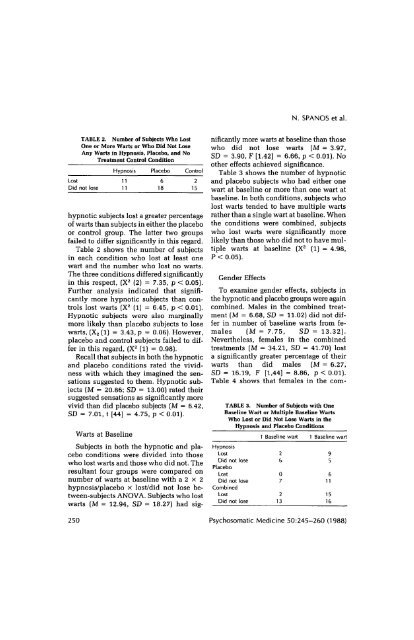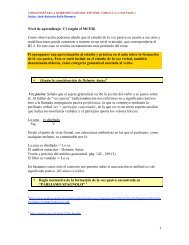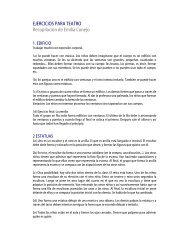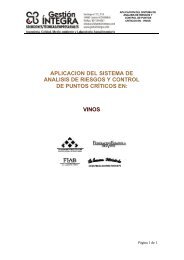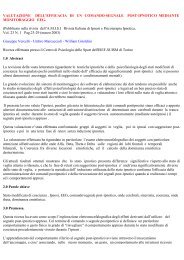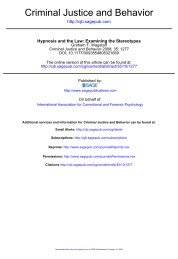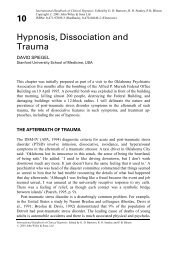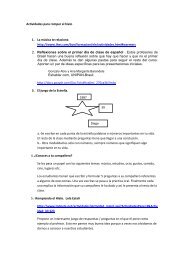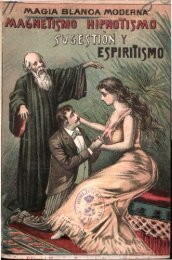Hypnosis, Placebo, and Suggestion in the Treatment of Warts
Hypnosis, Placebo, and Suggestion in the Treatment of Warts
Hypnosis, Placebo, and Suggestion in the Treatment of Warts
You also want an ePaper? Increase the reach of your titles
YUMPU automatically turns print PDFs into web optimized ePapers that Google loves.
N. SPANOS et al.TABLE 2. Number <strong>of</strong> Subjects Who LostOne or More <strong>Warts</strong> or Who Did Not LoseAny <strong>Warts</strong> <strong>in</strong> <strong>Hypnosis</strong>, <strong>Placebo</strong>, <strong>and</strong> No<strong>Treatment</strong> Control ConditionLostDid not lose<strong>Hypnosis</strong> <strong>Placebo</strong> Controlhypnotic subjects lost a greater percentage<strong>of</strong> warts than subjects <strong>in</strong> ei<strong>the</strong>r <strong>the</strong> placeboor control group. The latter two groupsfailed to differ significantly <strong>in</strong> this regard.Table 2 shows <strong>the</strong> number <strong>of</strong> subjects<strong>in</strong> each condition who lost at least onewart <strong>and</strong> <strong>the</strong> number who lost no warts.The three conditions differed significantly<strong>in</strong> this respect, (X 2 (2) = 7.35, p < 0.05).Fur<strong>the</strong>r analysis <strong>in</strong>dicated that significantlymore hypnotic subjects than controlslost warts (X 2 (lj = 6.45, p < 0.01).Hypnotic subjects were also marg<strong>in</strong>allymore likely than placebo subjects to losewarts, (X 2 (l) = 3.43, p = 0.06). However,placebo <strong>and</strong> control subjects failed to differ<strong>in</strong> this regard, (X 2 (1) = 0.98).Recall that subjects <strong>in</strong> both <strong>the</strong> hypnotic<strong>and</strong> placebo conditions rated <strong>the</strong> vividnesswith which <strong>the</strong>y imag<strong>in</strong>ed <strong>the</strong> sensationssuggested to <strong>the</strong>m. Hypnotic subjects[M = 20.86; SD = 13.00) rated <strong>the</strong>irsuggested sensations as significantly morevivid than did placebo subjects (M = 6.42,SD = 7.01, t [44] = 4.75, p < 0.01).<strong>Warts</strong> at Basel<strong>in</strong>eSubjects <strong>in</strong> both <strong>the</strong> hypnotic <strong>and</strong> placeboconditions were divided <strong>in</strong>to thosewho lost warts <strong>and</strong> those who did not. Theresultant four groups were compared onnumber <strong>of</strong> warts at basel<strong>in</strong>e with a 2 x 2hypnosis/placebo x lost/did not lose between-subjectsANOVA. Subjects who lostwarts (M = 12.94, SD = 18.27) had significantlymore warts at basel<strong>in</strong>e than thosewho did not lose warts [M = 3.97,SD = 3.90, F [1.42] = 6.66, p < 0.01). Noo<strong>the</strong>r effects achieved significance.Table 3 shows <strong>the</strong> number <strong>of</strong> hypnotic<strong>and</strong> placebo subjects who had ei<strong>the</strong>r onewart at basel<strong>in</strong>e or more than one wart atbasel<strong>in</strong>e. In both conditions, subjects wholost warts tended to have multiple wartsra<strong>the</strong>r than a s<strong>in</strong>gle wart at basel<strong>in</strong>e. When<strong>the</strong> conditions were comb<strong>in</strong>ed, subjectswho lost warts were significantly morelikely than those who did not to have multiplewarts at basel<strong>in</strong>e (X 2 (1) = 4.98,P < 0.05).Gender EffectsTo exam<strong>in</strong>e gender effects, subjects <strong>in</strong><strong>the</strong> hypnotic <strong>and</strong> placebo groups were aga<strong>in</strong>comb<strong>in</strong>ed. Males <strong>in</strong> <strong>the</strong> comb<strong>in</strong>ed treatment(M = 6.68, SD = 11.02) did not differ<strong>in</strong> number <strong>of</strong> basel<strong>in</strong>e warts from females(M = 7.75, SD = 13.32).Never<strong>the</strong>less, females <strong>in</strong> <strong>the</strong> comb<strong>in</strong>edtreatments (M = 34.21, SD = 41.70) losta significantly greater percentage <strong>of</strong> <strong>the</strong>irwarts than did males (M = 6.27,SD = 16.19, F [1,44] = 8.86, p < 0.01).Table 4 shows that females <strong>in</strong> <strong>the</strong> com-TABLC 3. Number <strong>of</strong> Subjects with OneBasel<strong>in</strong>e Wart or Multiple Basel<strong>in</strong>e <strong>Warts</strong>Who Lost or Did Not Lose <strong>Warts</strong> <strong>in</strong> <strong>the</strong><strong>Hypnosis</strong> <strong>and</strong> <strong>Placebo</strong> Conditions1 Basel<strong>in</strong>e wart 1 Basel<strong>in</strong>e wart<strong>Hypnosis</strong>LostDid not lose<strong>Placebo</strong>LostDid not loseComb<strong>in</strong>edLostDid not lose2607213956111516250 Psychosomatic Medic<strong>in</strong>e 50:245-260 (1988)


